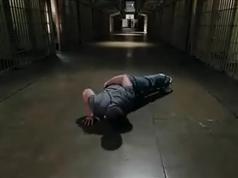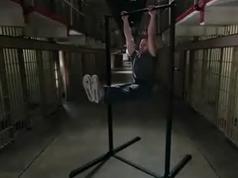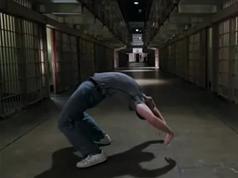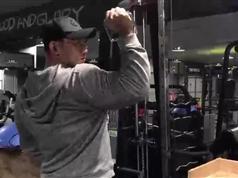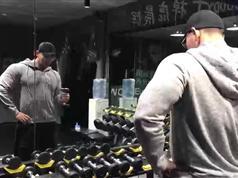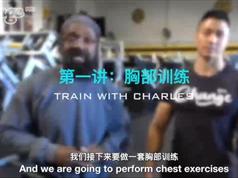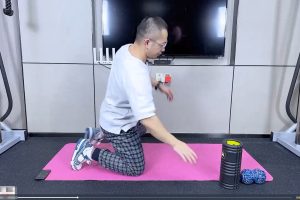资源简介:
◎字 幕 N/A
◎片 长 150 mins
芭蕾舞演员为什么具备优美的体态?
亚历山大技术(Alexander Technique,一种使运动机能和心理机能得以协调和康复的身体训练方法。它还可以帮助舞蹈家,歌唱家,运动员和他们更好地发挥所长。 亚历山大技巧与瑜珈有何不同? 瑜珈是一种运动,但亚历山大技巧并不能算是一种运动.. 他是教导你如何养成良好的身体使用方式,并增加大脑以及身体之间的协调性。长期练习瑜珈可以增进身体的柔软度及协调性,若练习方法正确,对身体有相当大的 好处,但是真正了解瑜珈内涵以及如何正确练习的人并不多,所以因为练瑜珈而受伤的意外时有所闻。亚历山大技巧可以说是瑜珈等各种运动的基础,若您可以将亚 历山大技巧的原则应用在瑜珈上,那么您将可以从练习瑜珈当中获得更多的好处并且大幅降低受伤的可能。此外,亚历山大技巧和瑜珈等其他运动都对身心健康有很 大的帮助,但是亚历山大技巧最大的特色和优点是-- 亚历山大技巧能够24小时被运用在我们的生活中,不需要额外挪出时间练习,或仅需很少的练习时间,而且他对我们的好处以及帮助也是不分时间地点或活动种类 的。
By changing your posture you can look, move, and even breathe better, according to proponents of this century-old technique popular with entertainers. Developed by an actor who lost his voice due to improper posture, the Alexander Technique involves a series of subtle changes in stance and movement that, once learned, are to be incorporated into everyday life. Actor William Hurt introduces viewers to the video and demonstrates the positions and movements. Hurt must truly believe in this method because not only does he allow himself to be an on-screen guinea pig for 74 minutes, but the reclusive actor has also made rare television appearances promoting the video. However much he appears to believe in the technique, though, the Oscar winner displays uncharacteristic awkwardness in introducing and quizzing his teacher, Jane Kosminsky. A former dancer, Kosminsky is well versed in the history and method of the technique as she moves Hurt through head placement, chair work, "the Monkey" (a lifting position), walking, and finally a 22-minute self lesson. At the tape's end Kosminsky warns that a personal teacher may be needed to truly learn the technique, and offers a contact number and Web site information.
让我们来看一种更为健康的对脖子的按摩方式,它是由马 蒂亚斯·亚历山大发明的,因此被命名为“亚历山大技术”。这位澳大利亚人的发明从原理上看很简单,只是设法通过身体运动,改变脖子的基本姿态,事实证明它 不仅能够消除某些身体不适的症状,同时也能对相当多的心理不适加以治疗。有些批评家认为,亚历山大技术的传播容易让人形成某些误解,认为脖子具备某种让它 超越了身体其他部位的神秘的力量。但实际情况其实是很单纯、很好解释的,因为都市人每天都花费了太多的时间伏案工作,或者是懒散地躺在椅子上休息,导致他 们的脖子逐步失去了天然的、垂直的姿态,如果让他们经受亚历山大式的训练,他们的颈部健康是可以被重新确立的,而身体的其他部位也会自动做出与之相适应的 调整,从而恢复人体的原有平衡。如此一来人类的身体健康将得到改善,而他们的精神状况也会因此变得更健康。亚历山大技术所规定的各种身体训练实际上并不比 芭蕾舞演员所接受的身体训练更神秘,在接受这两种身体训练时,脖子都是关系到身体平衡的最核心的因素。
这个动作也是一个亚历山大老师极力推荐坚持每天做的。对背疼的帮助听说是相当的大。本资料专门演示了背痛的亚历山大技术疗法。
The Alexander Technique Lie-Down
How to bring constructive rest into your life. WHY?
If you could learn and utilize a daily, 20-minute activity that would gain you renewed energy, easier balance, increased efficiency in mental and physical activities, and lessened pain and stress would you be interested? In an average day of 12 to 16 hours of uprightness, you will ask your body to expend a great deal of energy. Your muscles, tendons, and ligaments not only use energy to provide the force to move you through space, they are also in constant demand to stabilize and maintain your vertical (upright) posture. A brief, 20-minute period of horizontal rest allows overused, fatigued, and painful muscles to release, the natural curves in your spine to balance their forces, and a respite from any stresses in your day. The Alexander Technique "lie-down" is a powerful tool of self-care that, when included in your health and well-being regimen, can bring profound improvements in your daily functioning. WHEN?
The Alexander Technique lie-down is intended as a tool of prevention. Used consistently, it can deter future misuses of your structure that lead to painful imbalances. Although back pain can often be alleviated during a lie-down, your 20-minute time will yield a longer term health investment if you use it regularly, rather than choosing to lie down only _after_ your pain has made you aware of yourself. It's recommended that you lie down in the "position of mechanical advantage" at least once a day for 20 minutes; preferably in the middle of the day. All of us have had to search for extra time in the day to use for ourselves and often have difficulty finding it! Try remembering your true motivation: "when practicing my ability to stop and be present to myself, I can be truly present to others and to my environment." Include the lie-down time as part of your daily routine -- if you don't have 20 minutes, but you do have 10, then lie down for 10 minutes. If you can fit in more than one 20-minute lie-down, by all means, lie down more than once in the course of your day. However, do not lie down for longer than 20 minutes at a time. After 20 minutes, your body/mind will begin to recognize the additional minutes as a cue that this is sleeptime, rather than a short rest period. If you are a musician, you will get more value out of practice time if you lie down five minutes out of every half-hour of playing time. If you do physical fitness training, lie down before you work out to help prevent injury to over-fatigued muscles. Or lie down after working out in order to rest and re-balance before dashing back to work. If you do a lot of desk/computer work, set your timer for a five minute lie-down every 1-1/2 to 2 hours. You'll probably find your aching shoulders and neck releasing, as well as a refreshed outlook on your work tasks. Having some trouble sleeping at night? You may want to lie down just before getting into bed, although this should be in addition to another lie-down time during the day. HOW?
1. Find a quiet, draft-free place on the floor or a large flat table (conference tables work well!). Lie on a carpet, a blanket, or an exercise mat--do not use a bed. (It is the even and firm stimulus of the floor that will help your back rebalance; beds will compress at the heavier parts of your torso, such as your shoulders and hips.) You will also need a small pile of paperback books to rest your head on. Start by sitting on your sit bones with your legs extended in front of you. They can be bent, but do not cross them. You arms are in your lap or released with your hands by your sides.
2. Lean forward easily over your legs by moving from your hip joints. Think of the crown of your head extending out over your feet. Your arms should be relaxed at your sides. Your spine will be lengthening. (Check to make sure you are not aiming your nose for your knees; you will probably feel this as a crunching of your spine.) When you feel that your lower back has lengthened slightly, let your head drop forward from the top of your neck and begin to roll back to lie down. Your hips will go down first, then your back, then your shoulders and head. This movement is done smoothly and easily. It is not a test of the strength of your abdominal muscles; just let your stomach muscles release as you roll back. Reach back and move the pile of books so that the base of your skull rests on them. The books should not touch your neck; rather your neck hangs freely. You may want to use a folded washcloth as a pad if you have a bumpy ridge at the base of your skull.
3. The pile of books under your head should be high enough to fill the space made by the natural curve in your neck. There is a slight forward rotation of your head in relation to your neck. If you feel your jaw is pressing on your throat, you have too many books under your head. If your eyes seem to be looking behind you or your head is rotating backward on your neck, you have too few books under your head. Experiment with the height of the book pile; it will change over time and may even change within the 20 minutes you are lying there. Using a number of thinner books allows you to easily change the height of the pile.
4. After a few seconds of letting your entire body weight settle into the floor, bring your forearms up so that your elbows are directed away from your sides and your hands are resting on your lower ribs. Let your hands lay rested on your torso with fingers extended. Think about letting the full weight of your arms rest on the floor.
5. Bring your legs up one at a time so that your knee is pointing up to the ceiling and your foot is flat on the floor. Your legs should be about shoulder-width apart and your feet are as close to your rear as is comfortable. Rather than "holding" the legs up by squeezing in the groin and pulling the knees together, let them point up to the ceiling the same distance apart as your feet. If you like, you can turn your feet out slightly.
6. After you bring your legs up, your spine will lengthen slightly. You may wish to push the pile of books back a bit. They should be under your head and not touching your neck, which hangs free.
7. Bring your mind to allowing your body weight to settle into the floor. Let the full weight of your head rest on the pile of books. Notice where you are holding onto the muscles of your body and think about letting them release their unnecessary work. Let your breathing be easy and regular. During the 20 minutes, let your mind regularly return to these observations; when you notice yourself "holding on," think about letting your head's weight rest completely on the pile of books once again and release yoru full body weight onto the floor.
8. After 20 minutes, get up by rolling your head to the side, followed by your arms and shoulders, then hips and legs. Bring yourself onto hands and knees and slowly bring yourself to standing. Remember to breathe easily during this sequence, holding your breath will lock up your newly released and balanced torso and will make movement more difficult.
声明:本站所有资源版权均属于原作者所有,这里所提供资源均只能用于参考学习用,请勿直接商用。若由于商用引起版权纠纷,一切责任均由使用者承担。如若本站内容侵犯了原著者的合法权益,可联系我们进行处理,邮箱:502212423@qq.com。

 成为VIP
成为VIP
